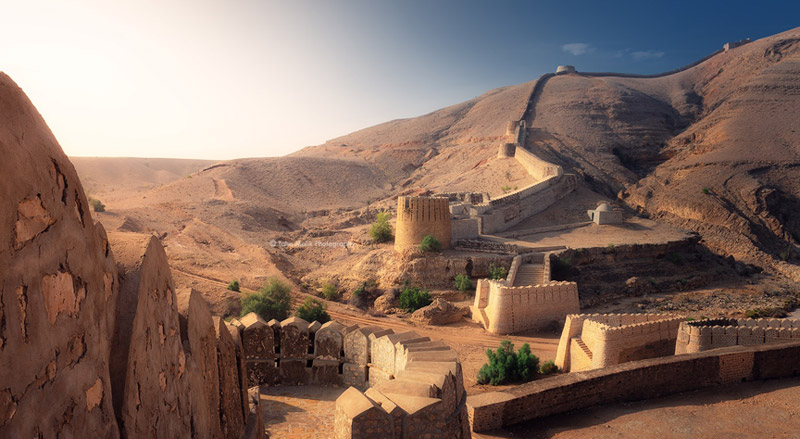The Kirthar National Park, a vast rugged national park in southwest Sindh is situated in the Kirthar Mountain range near Karachi. It was founded in 1974 and stretches over 3,087 km² (about 1200 mi²), being the second largest National Park of Pakistan after Hingol National Park.
It is also the first National Park from Pakistan to be included in the 1975 United Nation’s list of National Parks around the world. Kirthar is an area of outstanding beauty and cultural heritage which provides important habitat for a variety of mammals, birds and reptiles are characteristic of the arid subtropics.
Approximately one-third of the park lies in the north of Karachi district and two thirds in the south-west Jamshoro district. The park is part of a 447,161 Hectare (ha) protected areas complex, being contiguous with Mahal Kohistan Wildlife Sanctuary (70,577 ha ) to the south and Hab Dam Wildlife Sanctuary (27,219ha) to the south-west. Surjan, Sumbak, Eri and Hothiano Game Reserve (40,632ha) lies just to the east of the park. There are two tourist centres in the Park managed by Sind Wildlife Management Board, namely Khar and Karchat. The centres offer cottage and dormitory accommodation and guides are available. There are some 671km of unmetalled roads within the park, most of which are negotiable only by four-wheel-drive vehicles.
In 1977, 1,480 wild goats and 430 urials were counted in the park and 2,141 chinkara in the park and adjacent Surjan, Sumbak, Eri and Hothiano Game Reserve. There are now over 5,000 wild goats, about 1,250 urials and less than 150 chinkara in the park, and a further 400 wild goat and 70 urials in the game reserve.

The isolation, wilderness and ruggedness that makes Kirthar National Park appealing for some may also bring with it a big potential for danger, especially for those who are not well prepared. The vast majority of trips go off without a hitch, but taking a few simple, precautionary steps can make a huge difference, should the unforeseeable occur. The chances of being a victim of the crime of any sort in the park are very low but not unheard of, it’s usually in the form of armed robbery and unattended cars getting broken into (such as when parked in remote areas). But, if you use common sense, then you’ll be fine, keep a low profile, hide valuables from view or in the boot or, better yet, leave them at home.
The isolation, wilderness and ruggedness that makes Kirthar National Park appealing for some may also bring with it a big potential for danger, especially for those who are not well prepared. The vast majority of trips go off without a hitch, but taking a few simple, precautionary steps can make a huge difference, should the unforeseeable occur
Temperatures here can shift dramatically during the summer months and dressing properly is an important way to beat the elements. Just as important is water, so prepare equally no matter what your itinerary is, even for short hikes or if you don’t plan on getting out of the car at all. If you’re bringing your own 4×4 vehicle, make sure your tyres are properly inflated (don’t forget the spare tyre) and bring a jack. Check coolant, oil and fuel levels. If you do not already have one, consider adding a winch to pull the vehicle out of difficult situations.
And as always, when you are hiking, consider bringing a first aid kit.
Driving on the hilly and rugged network of unpaved dirt roads in Kirthar National Park is a true adventure, and most of the visitors to this park come precisely to enjoy this type of driving, which cannot be found elsewhere in Sindh. Expect a bumpy ride, no matter which direction you head to. The roads can even take you to the most remote parts of the park that are otherwise hard to access. For a true adventurer, driving the more remote and less maintained primitive dirt roads is the way to go, but come prepared and be sure to take it slow. The roads are rough, sandy, rocky, and become even worse during the monsoon season when the rain makes pathways muddy and thus more challenging, but with the right vehicle and preparation, you can enjoy the experience even in the rain.
While driving is a thrilling experience, to enter the park and not take at least a short walk would be almost foolish. After all, recreation is a major aspect of the Kirthar National Park, and visitors come here to enjoy nature. The rugged and hilly terrain of the park offers a great landscape and makes a hike a nearly mandatory activity. Hiking is possible in some parts of the park where there are marked hiking trails. The trails are of varying difficulty and length, ranging from easy strolls to steep climbs, although a guide is usually required. You can even hunt in the game reserves of Kirthar National Park, but you’ll have to hire the services of a guided tour company in that case.
The primary attraction of the Kirthar National Park is its beautiful landscape and famous Ranikot Fort. Kirthar is one of the largest wildlife reserves in Pakistan, and viewing the wide variety of resident wildlife is one of the main reasons visitors come here. Sightings of many different species of birds are inevitable and the Sindh ibex, urials and chinkara are common. Hyena, jungle and desert cats and wolf encounters cannot be expected unless you search very hard since their numbers have decreased in recent years.
Kirthar National Park isn’t exactly long on man-made sights, the attraction is the park itself, and of course its wildlife but the park’s human history is also worth exploring.
Hub Dam. One of Pakistan’s largest dams is a major attraction in the south-west of the park and is a good place for water-based activities. The dam has produced a large reservoir on a river that courses through arid plains and low stony hills. Much of the reservoir’s shoreline is steep and stony.
Public transport doesn’t exist inside the park. A 4×4 remains the only and common way to explore the park, so bring your own if you have one. There are several hundred kilometres of roads throughout the park, but most are transitory dirt roads and four-wheel drive is definitely needed. Road signs are poor to non-existent so even if you’re bringing your own vehicle, it is strongly recommended to hire a guide from the visitor centres. In fact, you will need to go with a guide (it’s mandatory because they want to protect the park and its wildlife, but also to keep an eye on you to make sure you don’t wander off the beaten path). A guide for the whole day can cost you not more than Rs. 1,000. The area needs a proper way to visitors, Tourism and Cultural department also make full efforts to make more convenient for the public.
The rangers at the visitors’ centre are generally useful and helpful in planning your visit and are on hand to answer all your questions.
The writer is a retired doctor of the Sindh Health Department
